Covid-19: How well is Northern Ireland's vaccination going?
 Pacemaker
PacemakerCovid-19 vaccinations have now opened up to another group in Northern Ireland - those 80,000 or so people who were in receipt of a shielding letter because they are classed as clinically extremely vulnerable (CEV).
The vaccination programme is crucial in the plan to exit lockdown and get on top of the virus.
But how well is it going?
Vaccinations progressing
Chief Medical Officer Dr Michael McBride has said we need to get between 70% and 80% of Northern Ireland's population vaccinated in order to start lifting restrictions fully.
But how far along that path are we? Well, in short, we still have some distance to go, but to date Northern Ireland's progress has been very good and it even looks to be accelerating.
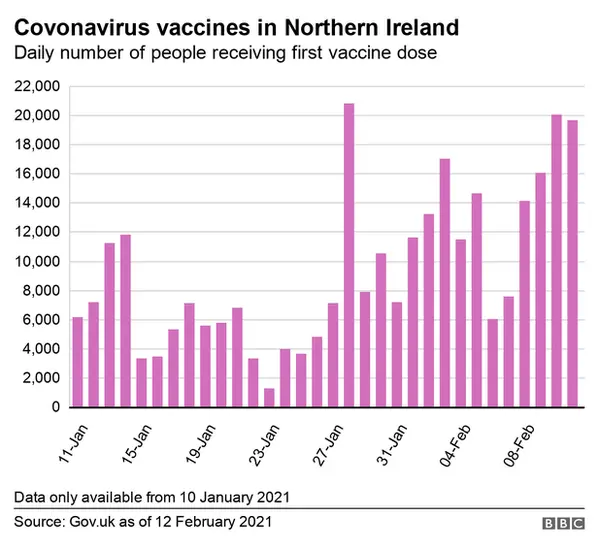
Up until 11 February, 373,414 people had received a first dose of a Covid-19 vaccine. This is just shy of 20% of Northern Ireland's overall population.
So based on first doses, and Dr McBride's target, we have another 50-60% of the population to get through.
It's possible to get a rough idea of when this could happen based on our current rate of vaccination. So let's look at how the rollout of the vaccine programme in NI has been going over the past two weeks.
Based on the figures we have, Northern Ireland has been averaging more than 12,500 first doses of a vaccine every day over the past fortnight. That's impressive.
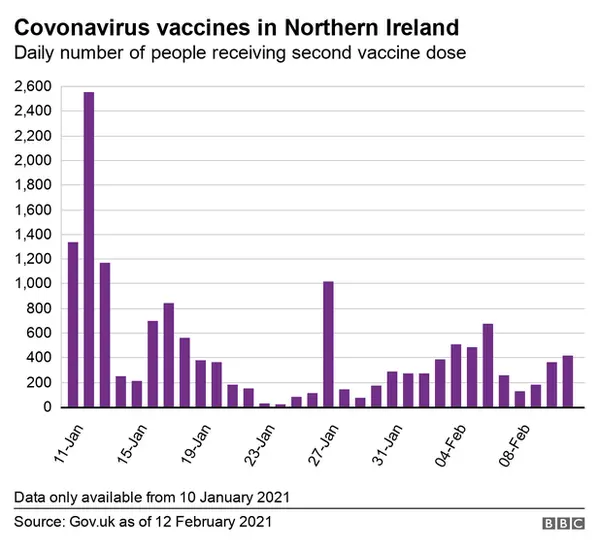
It's equivalent to nearly 5% of the population every week - and if we were able to keep up this rate of vaccination, we could hit that 70-80% figure around the middle of May.
Now, that projection comes with a few warnings. It's based on the availability of vaccine remaining the same. It presupposes a consistent rate of uptake of the vaccine.
There is also the issue that the rollout will naturally hit peaks and troughs as vaccinators approach the end of a particular eligible group.
And, eventually, more emphasis will have to be put on second doses. That may - or may not - affect the rate of first doses vaccinations between now and May.
In short, there are a lot of ifs involved.
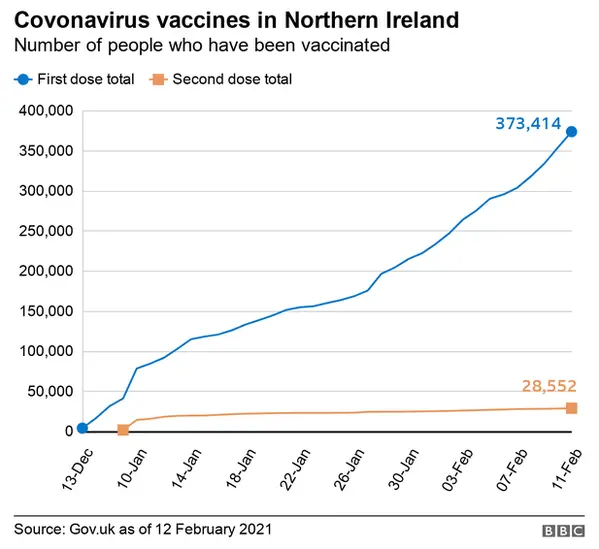
But while May might seem far off at the minute, it's a feasible target. And one which many other countries would be envious of.
Of note is the fact that for the latest two days in which figures have been published, there have been about 20,000 jabs administered per day in Northern Ireland.
This is a very small time window, but it does represent quite the increase in the speed of rollout.
Vaccination figures from across the UK show that Northern Ireland is slightly behind the rest of the UK when it comes to the proportion of the population which has received a first dose, but these differences are marginal.
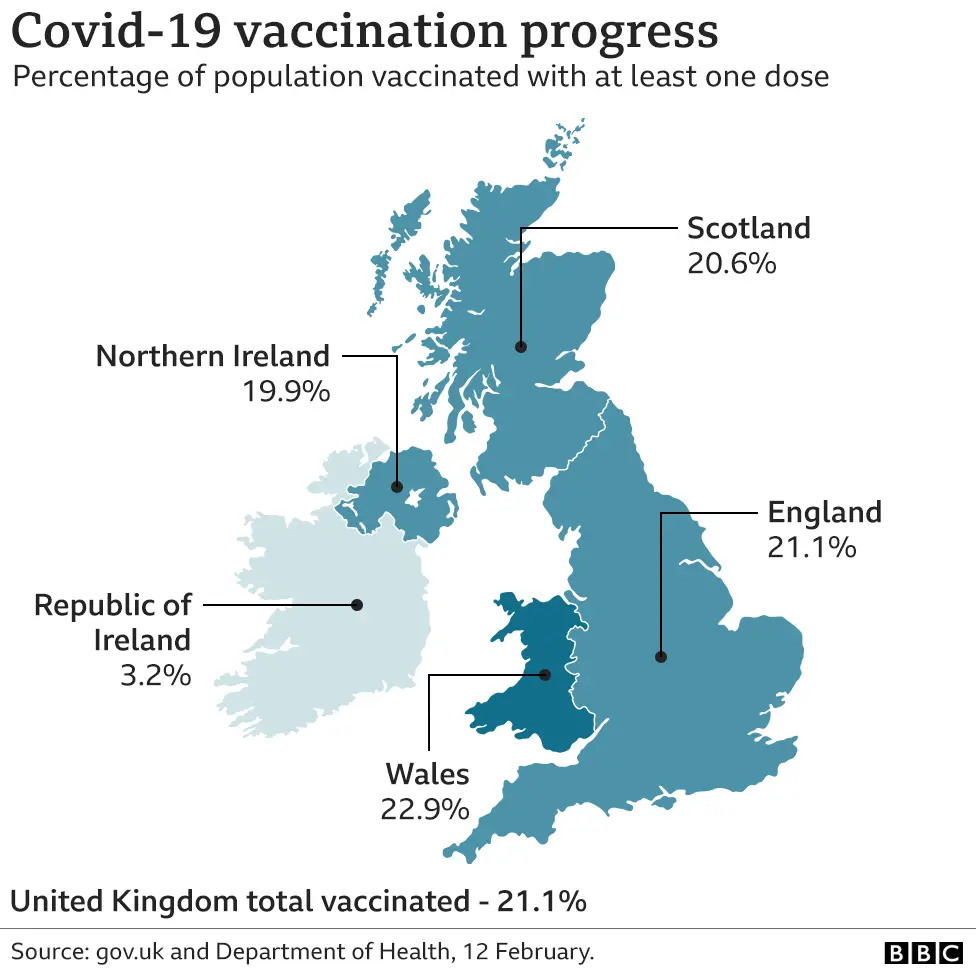
Northern Ireland's vaccine programme remains a success story.
The story in the Republic of Ireland is a very different one. In terms of first doses, there have been 158,904 given out - meaning about 3.2% of the population has received a jab.
While this obviously compares poorly to Northern Ireland, it is the current rate of rollout that is particularly slow. Over the past few weeks, the numbers of people getting a vaccine in the country have been rising, but very slowly indeed.
There are some reasons for this.
Ireland has adopted a different strategy than the UK and has not prioritised first doses to the same degree. More than half the people in Ireland who have had a first dose have also received their second dose.
Another reason may be the recent row between the EU and AstraZeneca.
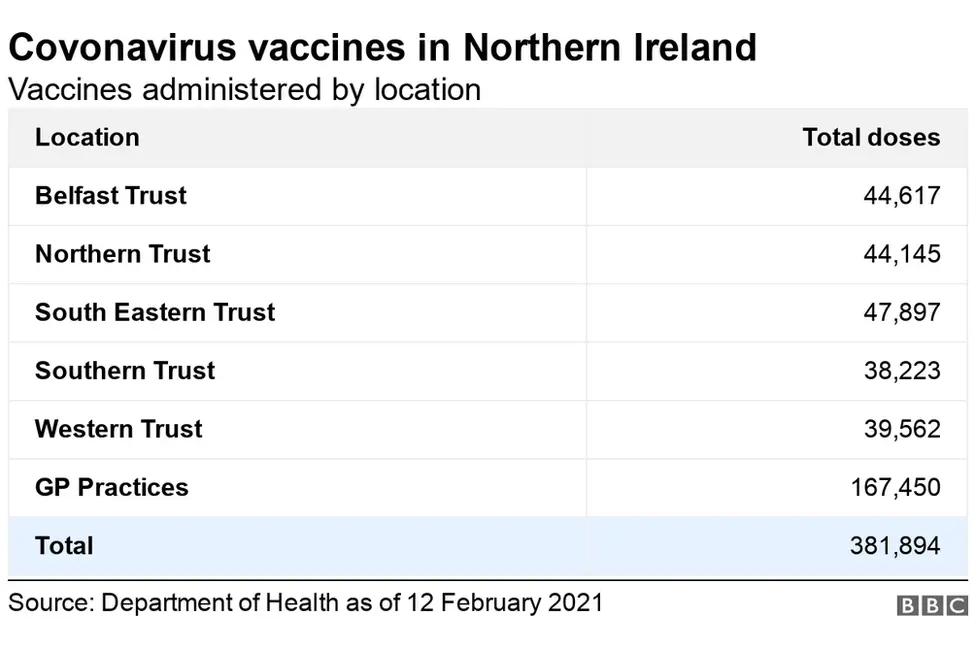
More than 99% of the doses administered in the Republic of Ireland have been Pfizer/BioNTech vaccines, which require very specific cold storage.
Ireland's vaccination rate, however, is one of the better ones in the EU.
Despite such a sluggish start, these rates are expected to speed up substantially in due course.
Infection rates downward trend continues
Coupling the vaccination programme with figures on infection rates, the picture is a positive one for Northern Ireland.
Statistics from the BBC's Data Unit for the week up until 6 February show falling Covid-19 infection rates across Northern Ireland.
This has been an ongoing trend for the past four weeks or so and many of Northern Ireland's council areas have some of the lowest infection rates in the UK.

Mid Ulster has the highest infection rate in Northern Ireland at 263 cases per 100,000 population, followed by Armagh City, Banbridge and Craigavon at 250 cases per 100,000 population.
Lisburn City and Castlereagh has the lowest infection rate in Northern Ireland at 86 cases per 100,000 population.
These falling rates are reinforced by the fact that the R number remains below 1.0.
In short, the spread of the virus has been - and continues to be - substantially reduced in Northern Ireland.
Hospitalisations down
With more and more people getting vaccinated, and infection rates continuing to be squeezed, the number of people in our hospitals suffering with coronavirus continues to fall steadily.
There are now fewer than half the number of Covid inpatients in Northern Ireland than there were a month ago.
On 13 January, we had more than 1,000 in hospital with the virus. Now there are fewer than 500.
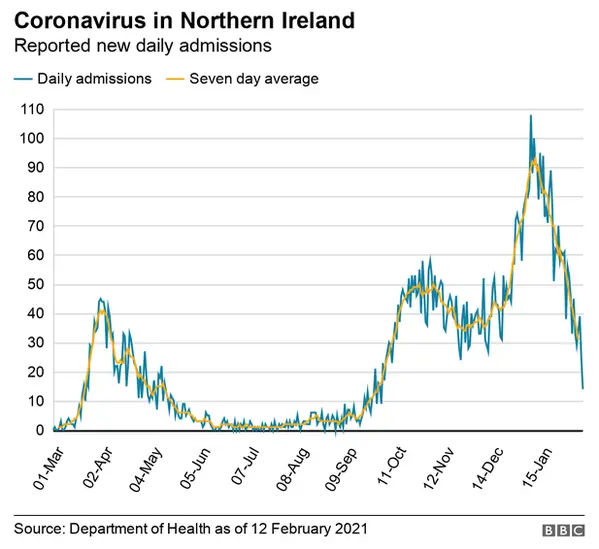
While that is a significant drop, there are still more Covid inpatients right now than at the peak of the first wave last April.
Admission rates have been falling as well, meaning that the overall number of Covid patients in our hospitals should continue to fall.
Intensive care units (ICUs) have also seen a very slight drop in numbers. But ICUs still remain very busy because of Covid-19 - almost half of patients in intensive care have coronavirus.
Deaths rate continues to fall
In a continuation of the trend for the past four weeks or so, Northern Ireland's Covid death rate is still falling.
The seven-day rolling average published by the Department of Health is down to seven expected deaths per day.
Comparing that to the first wave, it gives a good indicator that we've passed through the worst of the current surge.
Over the course of the pandemic, Northern Ireland and the Republic of Ireland have had very similar rates of death amongst those who have tested positive for Covid-19. This remains the case.

England, Scotland and Wales have all had much higher equivalent rates of death:
- Northern Ireland - 1 in 55 positive Covid cases has resulted in death
- Republic of Ireland - 1 in 53 positive Covid cases has resulted in death
- Wales - 1 in 39 positive Covid cases has resulted in death
- England - 1 in 34 positive Covid cases has resulted in death
- Scotland - 1 in 28 positive Covid cases has resulted in death
Also worthy of note is that two border counties - Monaghan and Cavan - have had the Republic ofI Ireland's highest death rates over the course of the pandemic.
Monaghan's infection rate remains one of the highest in the country, something that is mirrored just across the border in Tyrone and Armagh.
A stern reminder - if one was ever needed - that the virus respects no borders.
